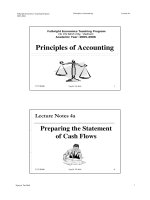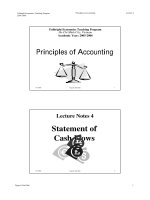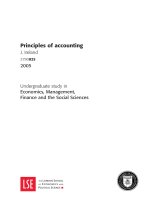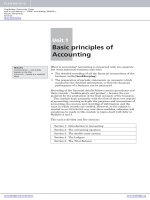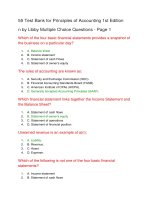business administration department subject principles of accounting acc101 fall2020 group individual assignment
Bạn đang xem bản rút gọn của tài liệu. Xem và tải ngay bản đầy đủ của tài liệu tại đây (4.26 MB, 32 trang )
<span class="text_page_counter">Trang 1</span><div class="page_container" data-page="1">
Student information
Mai Phương Thảo HS150709 Nguyễn Thục Khanh HS150080 Nguyễn Ánh Dương HS150579
</div><span class="text_page_counter">Trang 3</span><div class="page_container" data-page="3">Part 1: Business model :
I.Bibica company description : 1. Introduction :
-Bien Hoa Confectionery Joint Stock Company ( Bibica), formerly a candy workshop of Bien Hoa Sugar Factory (now Bien Hoa Sugar Joint Stock Company) was established in 1990, December 1998, according to the Decision No. 234 / 1998 / QD-TTG of the Prime Minister, the Confectionery-Nha workshop was changed to Bien Hoa Confectionery Joint Stock Company. With a production capacity at the beginning of 5 tons of candy / day, the company has gradually expanded operations, increased capacity and diversifiedproducts. Currently, the Company is one of the largest confectionery manufacturers in Vietnam with a designed capacity of 18 tons of cake / day, 18 tons of dental / day and 29.5 tons of confectionery / day.
-The number of employees for the corporate group as at 31 December 2019 was 1192 (2018 was 1515)
-As of December 31, 2019, the organizational structure includes 5 subsidiaries.
2. Operational functions:
- Domestic and foreign production and business in the fields of confectionery processing technology.
- Exporting bakery products and other goods.
- Importing equipment, technology, materials for the company's production.
3. The development of the Company :
-1999 :On January 16, 1999, Bien Hoa Confectionery Joint Stock Company with Bibicabrand was established from the equitization of three Factories: Biscuits, candies and malt of Bien Hoa Sugar Company Chartered capital is 25 billion VND. Expanding capacity of production line 11 tons / day of soft candy.
-2000:Increase charter capital, set up more factories
-2001September: Investing in a production line of moon cakes and cookies with a capacity of 2 tons / day with a total investment of VND 5 billion.
-2002 :Invest in the overall management system enterprise ERP
-2007 :Bien Hoa Confectionery Joint Stock Company officially changed its name to "Bibica Joint Stock Company" since January 17, 2007
</div><span class="text_page_counter">Trang 4</span><div class="page_container" data-page="4">-In April 2009: the Company started the construction of a high-class choco pie production line at Eastern Bibica, a line invested in the cooperation of Bibica and strategic partners. strategy is Korea Lotte Group
-2018 :For the first time, reaching a turnover of over 1,250 billion VND, consumers continue to vote for high quality Vietnamese goods for 21 consecutive years.
The company is implementing software to support business management: Production dispatching on ERP, BI leadership report and Sales App for Shop key. Groundbreaking ceremony of Western Bibica Factory in Long An.
-In October 2019, Bibica brought Western Bibica One Member Limited Company intooperation in Vinh Loc 2 Industrial Park, Ben Luc, Long An, for the first time the company's sales exceeded 1,500 billion VND.
4. Achievements achieved in recent years:
-Certificate of Merit from the Ministry of Finance, Dong Nai People's Committee for the submission of the state budget.
-Five years in a row consumers voted "High quality Vietnamese goods" -Certificate of ISO9002 issued by BVQI-UK
-Certificate of Merit from the Prime Minister to the company director.
5. Distribution system:
Currently, Bibica has a distribution system of more than 100,000 points of sale, 120 distributors, over 600 supermarkets / convenience stores, Bibica brand has also spread to 21 countries around the world such as the US, Japan, Singapore, Cuba.
II.Position:
-Bien Hoa Confectionery Joint Stock Company (Bibica) was voted by consumers as one of the top five companies in the confectionery industry in Vietnam. Bibica has won the title of "High Quality Vietnamese Goods" for 10 consecutive years (from 1997 to 2006). The company has a diversified and diversified product line consisting of main categories: Cookies, cookies, layer cakes, chocolate, hard candies, soft candy, marshmallows,snacks, nutritious cereal flour, cakes. Mid-Autumn Festival, malt ... On December 17, 2001 Bibica officially listed its shares at the Ho Chi Minh City Stock Center (HOSE) with the stock code as BBC.
</div><span class="text_page_counter">Trang 5</span><div class="page_container" data-page="5">-Bibica currently accounts for about 8% of the confectionery industry market share, ranking second, behind the giant Mondelez, the big man who owns the confectionerybrand Kinh Do. But if only domestic confectionery brands are included, this brand is the biggest.
III.Competitors: 1. Market overview:
Before the renovation period, the major confectionery manufacturers in the country were mainly state-owned economic units, with two main types of products: unsalted hard candies and biscuits. This leads to the import of many types of confectionery from outside as domestic production capacity cannot meet the rapidly increasing demand from improving people's income. Confectionery products gradually diversified. However, by the late 1990s, domestic products had regained most of the lost market share and now account for over 70% of the market price.
Joining the market today, there are more than 30 well-known confectionerymanufacturers in the market. The number of small confectionery manufacturers does not have accurate statistics, with low-quality confectionery products, consumed in individual locations. These establishments are estimated to account for 35-40% of the national confectionery market share.
2. Some competitors: 2.1. Domestic competitors:
- Kinh Do Construction and Food Processing Company (Kinh Do): competes with theCompany in cracker products in the Southern provinces. With a distribution network of 130 agents, Kinh Do products are distributed throughout the Vietnamese market,especially in Ho Chi Minh City. Kinh Do focuses on marketing activities with many measures such as advertising, promotions, high discount rates for agents and especially setting up a system of bakeries in Ho Chi Minh City, the main market of the Company. Kinh Do is also building a system of Bakery in Hanoi. In September 2001, the factory in Hung Yen of Kinh Do started to go into production. serving the North and North Central market. However, the selling price of Kinh Do company's products is at medium to quite high level compared to the products of other companies in the market, Currently, Kinh Do accounts for about 10% of the domestic confectionery market.
</div><span class="text_page_counter">Trang 6</span><div class="page_container" data-page="6">-Hai Ha Confectionery Company produces products in all five groups of cookies, biscuits, hard candies, truffles and marshmallows, but has a strong base in confectionery products. Hai Ha's products serve the low-end market with low average prices. With morethan 100 agents, Hai Ha has established a distribution system in 34 provinces and cities nationwide, mainly in the North and Central regions. Hai Ha's policy is to diversify products, especially products with typical flavors of Northern fruits such as lemon candy, plum ... while ensuring the stability of current product quality. The Company's market accounts for about 6.5% of the domestic confectionery market.
- Hai Chau Confectionery Company: similar to Hai Ha, Hai Chau's main market is the Northern provinces, products for the affordable market with low and medium sellingprices, Hai Chau accounts for about 3 % of the confectionery market,
-Quang Ngai Sugar Company: started to participate in the confectionery market in 1994, up to now the company has more than 60 confectionery products of all kinds. The main market for the company's confectionery products is the Central region. However, since confectionery is only one of many categories of Quang Ngai Sugar Company, the concentration of investment in confectionery is not great. Quang Ngai Sugar Company's market share is about 2.5%
There are also Lam Son Sugar Company, Lubico Bakery Enterprise, Trang AnConfectionery Company ...
2.2 Foreign competitors:
As units with foreign investment such as Vinabico-Kotobuki Joint Venture Company,Perfetti Confectionery Joint Venture Company…, these businesses all have technological advantages due to being newly established about four years ago. ,
-Vinaco-Kotobuki Joint Venture Company was established on November 12, 1992 withregistered business capital of 3,740,000 USD, focusing on production of cookies and biscuits. However, because the main market of Vinabico-Kotobuki is the import-export market, the company has less investment and advertising to expand domestic market
</div><span class="text_page_counter">Trang 7</span><div class="page_container" data-page="7">share. Vinabico-Kotobuki accounts for only about 1% of the domestic confectionery market.
-Perfetti- Vietnam Confectionery Manufacturing Joint Venture Company was formed onAugust 22, 1995 with registered business capital of 5,600,000 USD, focusing onproducing high quality hard candies Perfetti focusing on further work. town and town.Perfetti's products are stabilized at a high level, Perfetti accounts for about 60% of the domestically produced confectionery market.
Besides large manufacturers, small confectionery factories account for the majority,about 35% -40% of the total domestic confectionery production.
Imported products account for 30% of the market share (including official and unofficial), mainly from Thailand, Malaysia, Hong Kong and China...Some confectionery productscurrently imported by domestic units can be produced .
IV :Past-Present-Future:: 1.Past :
And while its competitors slow down to keep pace with the market, Bibica will speed up, increase capacity and scale to gain market share. During this period, the business sets the annual growth target of 20-25%.
Along with increasing production capacity, the company will promote building a distribution system and searching for new consumer markets. In 2016, thisbusiness had 95,000 points of sale. The target in 2017 is raised to 115,000 points of sale, by 2018 it will grow to 125,000 points.
This unit has also exported to 21 countries, including difficult markets like Japan.
Business leaders said that increasing groups of products with nutritional value and natural origin is the most important and fundamental issue in the new development stage.
However, product decentralization will fluctuate over time with a gradual increase in high-end products and a gradual decrease in the share of low-end products.
</div><span class="text_page_counter">Trang 8</span><div class="page_container" data-page="8">Market research firm BMI forecasts that the demand for confectionery of the domestic market by 2018 will reach about 40,000 billion VND
2. Present :
Bibica has the advantage of researching Vietnamese consumer tastes as well as selling styles and distribution systems. While competitors take a long time to learn, BIBICA confidently "is in tune with the market rhythm".
The confectionery industry in Vietnam currently has about 30 industrialmanufacturing enterprises, about 1,000 small establishments and severalimporters from abroad.
However, compared with the average of 1.5% in the world and 3% in Southeast Asia, the growth of the confectionery industry in Vietnam is still much higher, considered a potential land for many businesses. industry and abroad.
Currently, confectionery consumption per capita in Vietnam is only 2 kg / person / year, lower than the world average of 2.8 kg / person / year.
In particular, in the rural market, confectionery consumption is still very limited, promising to have a lot of growth potential.
According to the Vietnam Food Industry Development Plan to 2020, with a vision to 2030 of the Ministry of Industry and Trade, the structure of groups of food industry products in the direction of increasing the proportion ofconfectionery products.
Specifically, by 2020, the confectionery industry strives to achieve an output of 2,200,000 tons, accounting for 40.43% of the total structure of the food industry in Vietnam.
3.Future :
● According to the Vietnam Food Industry Development Plan to 2020, with a vision to 2030 of the Ministry of Industry and Trade, the structure of groups of food
</div><span class="text_page_counter">Trang 9</span><div class="page_container" data-page="9">industry products in the direction of increasing the proportion of confectionery products.
- By 2023, it will become the leading confectionery company in Vietnam; - Sales from 2018 to 2023 will grow by an average of 22% / year
- Focusing on the distribution system in big cities, sales of MT channel account for 30% of the total revenue of the Company.
● Medium and long term strategy: - Invest to expand production in Long An
- Develop high-quality confectionery lines and lines of nutritional and functional foods
- Using raw materials of natural origin, fresh and beneficial for health - Develop sales channels Key Account, Online.
● Sustainable Development:
- Develop a sustainable development policy to harmonize the interests of Shareholders, partners, employees and consumers. Comes with ensuring a high level of satisfaction work environment;
- Commitment to ensure contributions to the Government and the Community such as: Taxes, obligations and social contributions. The company alwaysensures business development associated with ensuring the requirements of environmental protection.
Part 2: Content of financial statements I List of reports found in the financial statements:
1. General information
2. Report of the board of directors 3. Independent auditor's reports 4. Consolidated balance sheet 5. Consolidated cash flow statements
6. Presentation of the consolidated financial statements
II Main contents that the readers can get from each report : 1. With < General information=
- Company - Board of directors
</div><span class="text_page_counter">Trang 10</span><div class="page_container" data-page="10">- Board of Supervisors - Board of General Directors - Legal representatives of enterprises - Auditor
2. With <Report of the board of directors=
- Board of Directors's Responsibilities for the Consolidated Financial Statements - Announcement of General Manager
3. With <Independent auditor's reports=
- Responsibility of the Board of General Directors - Responsibility of Auditor
- Auditor's opinion - Emphasized problems
4. With <Consolidated balance sheet= - Short-term assets
- Long-term assets - Liabilities - Equity
5. With =Consolidated income statement= - Revenue
- Expense
III. Company auditor 1. Company auditor - Auditor
+ Ernst & Young Vietnam Limited
2. Type of audit opinion
- Unqualified opinion-clean report (Financial statements, page 4, auditor's opinion)
</div><span class="text_page_counter">Trang 11</span><div class="page_container" data-page="11">IV. Principles that the company uses :
1. Record revenue
- Company uses the revenue recognition principle: Revenue is recognized when the company is likely to receive a reliably determinable economic benefit.
2. Record depreciation expense
- The Company uses the depreciation recognition principle: Straight-LineDepreciation
</div><span class="text_page_counter">Trang 12</span><div class="page_container" data-page="12">3. Record prepaid expense
- Company uses prepared expense recognition principle: Prepared expense will beallocated for the period of prepayment of costs in proportion to the economic benefits generated from these costs
4. Record inventory costing methods
- Companies using the inventory costing methods recognition principle: Apply theregular declaration method to account inventory
5. Record allowance for bad debts
- Allowances for bad debts are recognized in the administrative expense account in the consolidated income statement.
6. Record taxes
- Current income tax payable for the current and prior years is based on the tax rates and tax laws in force as of the balance sheet date
</div><span class="text_page_counter">Trang 13</span><div class="page_container" data-page="13">- Deferred income tax is defined between the tax base of the income of assets and liabilities and their carrying amount
Part 3: The detailed figures in the financial statements: Balance sheet items:
➤Cash and Cash equivalents
Cash equivalents represent short-term deposits at commercial banks with original terms of less than 3 months and earn interest at the rate of 5.4% -5.5% / year
➤Short-term accounts receivable
Year-end number (VND) The first number of the year (VND)
The first number of the year (VND) Short-term receivables from customers 134.522.947.180 126.390.612.629
Ho Chi Minh City Union of Trade Cooperatives
</div><span class="text_page_counter">Trang 14</span><div class="page_container" data-page="14">5.438.050.934 4.482.393.140
Year-end number (VND) The first number of the year (VND) Original price Preventive Original price Preventive Finished
products, goods <sup>58.101.632.306 </sup> <sup>50.212.248.040 </sup>Raw materials,
materials
53.192.313.187 (2.345.322.631) 47.015.152.744 (3.140.659.475)
Tools and instruments
4.175.354.843 (596.777.480) 4.177.865.418 (408.670.026)
Production costs of unfinished business
Total 119.019.919.369 (2.942.100.111) 104.676.073.284 (3.549.329.501)
</div><span class="text_page_counter">Trang 15</span><div class="page_container" data-page="15">Details of the situation increase or decrease
➤Other short-term assets Tax
Prepaid expenses
This year (VND) Last year (VND) The first number of the year 3.549.329.501 3.297.052.139 Provision made during the year 249.080.308 252.277.363. Provision reversal during the year (856.309.698)
Value Added Tax
Overpaid tax
Tax payable
</div><span class="text_page_counter">Trang 16</span><div class="page_container" data-page="16">➤Long-term assets Intangible fixed assets
Buildings and architecture
Machinery and equipment
Means of transportation
Office equipment
Other fixed assets
Total (VND)
Original price The first number of the
year
072.790 <sup>518.553.5</sup>32.008 <sup>14.049.7</sup>85.174 <sup>11.880.57</sup>1.492 <sup>183.695.1</sup>59 <sup>679956.65</sup>6.623
New purchase 9.174.388.500
2.677.501.454
66.029.800
11.917.919.754
75) Year-end
number <sup>135.289.</sup>072.790 <sup>526.941.8</sup>25.233 <sup>15.165.3</sup>59.405 <sup>11.947.60</sup>1.292 <sup>183.695.1</sup>59 <sup>689.526.5</sup>53. Including
Fully depreciated
17.006.030.493
188.860.101.608
6.827.605.300
9.485.505.074
140595.159
222.319.837.634
Accumulated depreciation
The first number of the
year
80.984 <sup>364.121.7</sup>5.841 <sup>10.913.8</sup>09.386 <sup>10.614.14</sup>2.583 <sup>176.811.1</sup>24 <sup>462.233.9</sup>19.898
Depreciation of the year
6.963.214.849
30.796.702.040
849.216.857
530.920.036
3.591.667 39.143.645.449
67)
(1.561.927.223)
(1.783.485.990) Year-end
number
83.371.195.833
394.696.319.114
10.201.099.020
11.145.062.599
180.402.791
499.594.079.357 Residual
value The first number of the
year
91.806 <sup>154.432.3</sup>56.167 <sup>3.135.97</sup>5.788 <sup>1.266.428.</sup>929 <sup>6.884.035 217.722.7</sup>36.725
Year-end 51.917.8 1332.245. 4.964.26 801.538.6 3.292.368 189.932.4
</div>
